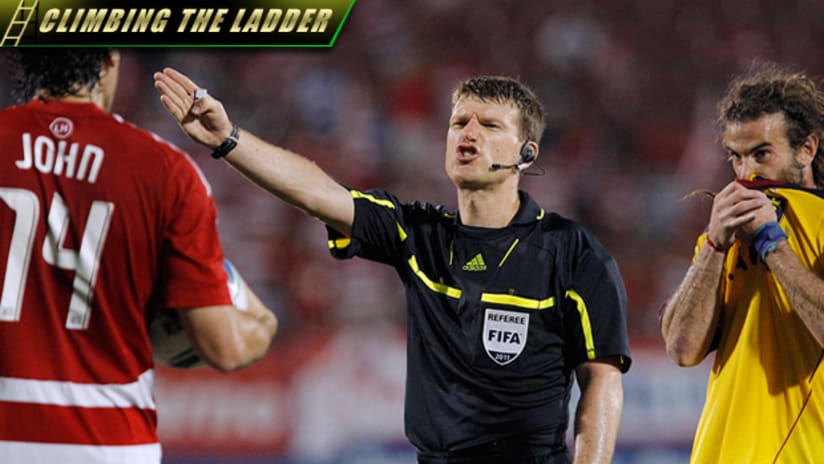It’s Referee Week here at MLSsoccer.com, and that makes it the perfect time to examine the officiating statistics over the league’s previous 15 seasons. How has the refereeing changed, and are there any changes in how games have been called during the regular season and the postseason?
First, let’s take a look at the stats for the regular season on a per game basis (at right).
| Per-Game Discipline in Regular Season | ||||
| Year | Fouls | Yellows | Reds | Penalties |
| 1996 | 27.70 | 3.26 | 0.18 | 0.31 |
| 1997 | 28.64 | 2.86 | 0.23 | 0.34 |
| 1998 | 28.14 | 3.22 | 0.31 | 0.29 |
| 1999 | 28.97 | 3.20 | 0.28 | 0.21 |
| 2000 | 33.97 | 3.83 | 0.28 | 0.34 |
| 2001 | 32.98 | 3.96 | 0.28 | 0.33 |
| 2002 | 32.56 | 4.09 | 0.31 | 0.34 |
| 2003 | 32.24 | 3.66 | 0.25 | 0.39 |
| 2004 | 30.49 | 3.53 | 0.23 | 0.33 |
| 2005 | 29.53 | 3.64 | 0.22 | 0.31 |
| 2006 | 29.03 | 3.59 | 0.23 | 0.23 |
| 2007 | 28.33 | 3.71 | 0.28 | 0.29 |
| 2008 | 24.81 | 3.59 | 0.28 | 0.23 |
| 2009 | 22.93 | 3.74 | 0.36 | 0.28 |
| 2010 | 21.98 | 3.11 | 0.23 | 0.23 |
| 2011 | 23.93 | 3.18 | 0.29 | 0.28 |
The most notable change throughout the years is the number of fouls. In 2008, the US Soccer Federation issued a directive to increase the flow of the game with fewer interruptions from minor infractions. Since then, there has been quite a noticeable decrease.
The 2000-2003 numbers are the highest due to the 10-minute sudden-death overtime period used in those four seasons. With that taken into consideration, the first 11 seasons were consistent until the change.
The number of yellow cards has gone down as well, but interestingly, not at the same time as the fouls. Last year, there was a big change from 2009 to 2010, which has continued this season as well.
Remember how this season began with a flurry of red cards, led by Vancouver’s Eric Hassli getting sent off seemingly in every other game? There were 22 ejections in the first 55 games, which meant early on 2011 was at a record pace of 0.40 per game.
However, as the season continued, the numbers have now ended up right around the all time average of 0.27 per game.
On a side note, MLS penalty-takers have made 77 percent of their attempts in league history. The success rate has been at least 75 percent in every year since 2003, which is a mark that was reached only once from 1996-2002.
How does the regular season compare to the postseason when it comes to these stats? The conventional wisdom would say that it’s harder to get a call come playoff time, but is that really true?
Well, it depends on the type of call. Game-changing red cards and penalty kicks have indeed been harder to come by (at right), to the tune of 15 percent less and 34 percent less often, respectively. When the season comes down to only a handful of games that decide who stays alive and who goes home, it may be more difficult for referees to make those tough judgment calls.
| Regular Season vs. Postseason, Per Game | ||||
| Regular | Postseason | Change | ||
| Fouls | 28.41 | 32.84 | +16% | |
| Yellows | 3.52 | 4.17 | +18% | |
| Reds | 0.27 | 0.23 | -15% | |
| Penalties | 0.29 | 0.19 | -34% | |
On the other hand, the playoffs have seen an increase in the number of fouls and yellow cards. The same reasoning behind fewer big calls, the huge importance of each game, is likely the cause as teams go all out for every tackle.
Now, what about the smaller number of playoff games? After all, the regular season is quite a bit larger in comparison. However, the average change when adding up the total for each individual year ends up being very close to the numbers for the overall games above.
| Percentage Change, Regular vs. Postseason | ||||
| Fouls | Yellows | Reds | Penalties | |
| 1996 | 5% | 19% | 30% | -62% |
| 1997 | 14% | 16% | -33% | -77% |
| 1998 | 23% | 29% | -77% | -27% |
| 1999 | 22% | 35% | -33% | 17% |
| 2000 | 10% | 26% | -33% | 17% |
| 2001 | 7% | 19% | 134% | -49% |
| 2002 | 8% | -1% | -25% | -30% |
| 2003 | 8% | 12% | -64% | -53% |
| 2004 | 16% | 31% | -61% | 11% |
| 2005 | 23% | 22% | 25% | -70% |
| 2006 | 20% | -1% | 19% | 19% |
| 2007 | 6% | 15% | -2% | -100% |
| 2008 | 6% | 27% | -35% | -20% |
| 2009 | 14% | 2% | -75% | -3% |
| 2010 | 13% | 17% | -19% | -100% |
Indeed, every single postseason has seen an increase in fouls per game, ranging from up 5 percent in 1996 to up 23 percent in 1998. The average increase has been 13 percent.
Yellow cards have been higher in 13 of 15 seasons, while red cards and penalties have been lower in 11 seasons apiece. The latter two are fewer in number and have more variance from year to year.
For instance, there were 12 players sent off in 18 playoff games in 2001, and also a couple years without a playoff penalty. But overall, the trends are there.
It’s never easy for a referee to take charge of a huge game. Just ask Howard Webb, the man in the center for last year’s World Cup final, who admitted later that he should’ve sent off the Netherlands’ Nigel de Jong in the first half.
When it comes to a game changing call like a red card or penalty, referees appear to be more inclined to be absolutely sure that they are right in the MLS playoffs.














